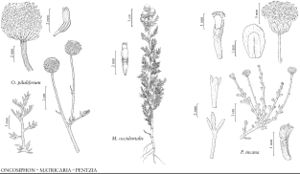Pentzia
Prodr. Pl. Cap., 145. 1800.
| Taxon | Illustrator ⠉ | |
|---|---|---|
 | Oncosiphon piluliferum Matricaria occidentalis Pentzia incana | John Myers Yevonn Wilson-Ramsey John Myers |
Shrubs [subshrubs], [5–] 15–35 [–50] cm (usually aromatic). Stems 1–10+, usually much branched, ± tomentose (hairs medifixed) [glabrate or glabrous]. Leaves cauline (often fascicled, ± ericoid); alternate [opposite]; petiolate or sessile; blades linear to obovate or cuneate, often 1 [–2] -pinnately lobed, ultimate margins entire or toothed, faces ± tomentose [glabrate or glabrous]. Heads discoid, borne singly or in loose, corymbiform arrays (pedunculate). Involucres spheric to hemispheric or broader, 3–6 [–12+] mm diam. Phyllaries persistent or tardily falling, 22–40 [–60+] in 3–4+ series, distinct, deltate-ovate to elliptic or obovate (sometimes each with central resin canal and/or keel), unequal, margins and apices (often hyaline, sometimes brownish) ± scarious (tips of inner ± dilated). Receptacles conic [convex to hemispheric], epaleate. Ray-florets 0. Disc-florets 40–100 [–200+], bisexual, fertile; corollas yellow, tubes ± cylindric (usually dilated, with relatively thick vascular strands), throats abruptly dilated, lobes 5, triangular. Cypselae narrowly obovoid to oblong or elliptic, ± terete or flattened, ribs 5, faces gland-dotted between ribs (pericarps with myxogenic cells abaxially and along ribs); pappi of 1 (often cupped or earlike) or 3–5 (erose to lacerate) scales (usually more developed adaxially) [asymmetrically coroniform or 0]. x = 9.
Distribution
Introduced; Africa (mostly South Africa), Africa (also Namibia and Mediterranean Africa and adjacent areas)
Discussion
Species ± 23 (1 in the flora).
Selected References
None.
Lower Taxa
"broader" is not a number.